Norfolk Southern Railway
 | |
|
NS system map; trackage rights in purple | |
_(north_of_Inaha%2C_Georgia%2C_USA)_1_(22813045600).jpg) | |
| Reporting mark | NS |
|---|---|
| Locale | Eastern United States |
| Dates of operation | 1982–Present |
| Predecessor | |
| Track gauge | 4 ft 8 1⁄2 in (1,435 mm) standard gauge |
| Length | 21,500 miles (34,600 kilometres) |
| Headquarters | Norfolk, Virginia |
| Website | nscorp.com |
 | |
|
NS headquarters building in Norfolk, Virginia | |
| Public | |
| Traded as |
NYSE: NSC DJTA Component S&P 500 Component |
| Industry | Transportation |
| Founded | Norfolk, Virginia, USA (July 23, 1980) |
| Headquarters | Norfolk, Virginia, United States |
Key people | |
| Revenue | |
| Total assets | |
| Total equity | |
Number of employees |
|
| Website |
nscorp |
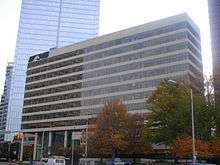
The Norfolk Southern Railway (reporting mark NSC) is a Class I railroad in the United States; began in 1982 and 1990. With headquarters in Norfolk, Virginia, the company operates 36,200 route miles in 22 eastern states, the District of Columbia,[3] and has rights in Canada from Buffalo to Toronto and over the Albany to Montreal route.[4][5] NS is responsible for maintaining 29,000 miles, with the remainder being operated under trackage rights from other parties responsible for maintenance.[6] The common commodity hauled on the railroad is coal from mines in Indiana, Kentucky, Pennsylvania, Tennessee, Virginia, and West Virginia. The railroad also offers the largest intermodal network in eastern North America.
NS is a major transporter of domestic and export coal. The railroad's major sources of the mineral are located in: Pennsylvania's Cambria and Indiana counties, as well as the Monongahela Valley; West Virginia; and the Appalachia regions of Virginia, Kentucky, and Tennessee. In Pennsylvania, NS also receives coal through interchange with R.J. Corman Railroad/Pennsylvania Lines at Cresson, Pennsylvania, originating in the "Clearfield Cluster". NS's export of West Virginia bituminous coal, begins transport on portions of the well-engineered former Virginian Railway and the former N&W double-tracked line in Eastern Virginia to its Lambert's Point coal pier on Hampton Roads at Norfolk. Coal transported by NS is thus exported to steel mills and power plants around the world. The company is also a major transporter of auto parts and completed vehicles. It operates intermodal container and TOFC (trailer on flat car) trains, some in conjunction with other railroads. NS was the first railway to employ roadrailers, which are highway truck trailers with interchangeable wheel sets.
The Norfolk Southern Railway's parent Norfolk Southern Corporation is a Norfolk, Virginia-based parent company. Norfolk Southern Corporation was incorporated on July 23, 1980 in the Commonwealth of Virginia and is publicly traded on the New York Stock Exchange (NYSE) under the symbols NSC. The primary business function of Norfolk Southern Corporation is the rail transportation of raw materials, intermediate products, and finished goods across the Southeast, East, and Midwest United States. The corporation further facilitates transport to the remainder of the United States through interchange with other rail carriers while also serving overseas transport needs by serving several Atlantic and Gulf Coast ports. As of October 1, 2014 Norfolk Southern Corporation's total public stock value was slightly over $34.5 billion.
History
The system began in 1982 with the creation of the Norfolk Southern Corporation, a holding company for the Southern Railway (SOU, formed in 1894) and Norfolk & Western Railway (N&W, formed in 1881). The new company was given the name of the Norfolk Southern Railway, an older line, acquired by SOU in 1974, that served primarily North Carolina and the southeastern tip of Virginia. Headquarters for the new NS were established in Norfolk, Virginia. The company suffered a slight embarrassment when the marble headpiece at the building's entrance was unveiled, which read "Norfork Southern Railway". A new headpiece replaced the erroneous one several weeks later.[7] NS aimed to compete in the eastern United States with CSX Transportation, formed after the Interstate Commerce Commission's 1980 approval of the merger of the Chessie System and the Seaboard System.
Norfolk Southern's predecessor railroads date to the early 19th century.
The SR's earliest predecessor line was the South Carolina Canal & Rail Road. Chartered in 1827, the South Carolina Canal & Rail Road Company became the first to offer regularly scheduled passenger train service with the inaugural run of the Best Friend of Charleston in 1830.[8] Another early predecessor, the Richmond & Danville Railroad (R&D), was formed in 1847 and expanded into a large system after the American Civil War under Algernon S. Buford. The R&D ultimately fell on hard times and in 1894, it became a major portion of the new Southern Railway (SOU). Financier J. P. Morgan selected veteran railroader Samuel Spencer as president. Profitable and innovative, Southern became in 1953 the first major U.S. railroad to completely switch to diesel-electric locomotives from steam.
The City Point Railroad, established in 1838, was a 9-mile (14 km) railroad in Virginia that started south of Richmond — specifically, City Point on the navigable portion of the James River, now part of the independent city of Hopewell — and ran to Petersburg. It was acquired by the South Side Railroad in 1854. After the Civil War, it became part of the Atlantic, Mississippi & Ohio Railroad (AM&O), a trunk line across Virginia's southern tier formed by mergers in 1870 by William Mahone, who had built the Norfolk & Petersburg Railroad in the 1850s. The AM&O was the oldest portion of the Norfolk & Western (N&W) when it was formed in 1881, under new owners with a keen interest and financial investments in the coal fields of Western Virginia and West Virginia, a product which came to define and enrich the railroad. In the second half of the 20th century, the N&W acquired the Virginian Railway (1959), the Wabash Railway, and the Nickel Plate Road, among others.[9]
In 1990, the two systems merged and formed Norfolk Southern Railway.
The system grew with the acquisition of over half of Conrail. In 1996, CSX bid to buy Conrail. Norfolk Southern, fearing that CSX would come to dominate rail traffic in the eastern U.S., responded with a bid of its own. On June 23, 1997, NS and CSX filed a joint application with the Surface Transportation Board (STB) for authority to purchase, divide, and operate the assets of Conrail. On June 6, 1998, the STB approved the NS-CSX application, effective August 22, 1998. NS acquired 58% of Conrail assets, while CSX got the remaining 42%, including about 7,200 miles (11,600 km) of track, most of which was part of the former Pennsylvania Railroad. NS began operating its trains on its portion of the former Conrail network on June 1, 1999, closing out the 1990s merger era. The Consolidated Rail Corporation (Conrail) was a 11,000-mile (18,000 km) system formed in 1976 from the Penn Central Railroad (1968–1976),[9] by bringing together several ailing northeastern railway systems into a government-owned corporation. Conrail was perhaps the most controversial conglomerate in corporate history. Penn Central itself was created by merging three venerable rivals — the Pennsylvania Railroad (PRR, 1846), the New York Central Railroad (NYC, 1831), and the New York, New Haven & Hartford Railroad (NYNH&H, 1872) — as well as some smaller competitors. Conrail had become profitable after the Staggers Act in 1980 largely deregulated the U.S. railroad industry. Norfolk Southern and CSX Transportation have a duopoly over all east-west freight rail traffic east of the Mississippi River.
According to NS's 2015 Annual Report to Investors, at the end of 2015, NS had more than 30,456 employees, 4,353 locomotives, and 76,641 freight cars. At the end of 2015, the transport of coal made up 17% of the total operating revenue of NS, general merchandise (automotive, chemicals, metals, construction materials, agriculture commodities, consumer products, paper, clay, and forest products) made up 62%, and intermodal made up 23% of the total.
In 2016 a proposed merger that had been months in the pipeline with Canadian Pacific was abandoned abruptly. The proposed merger would have seen the joining of two companies worth over $20 billion each.
Company officers
- Robert B. Claytor, CEO: 1982–1987
- Arnold B. McKinnon, CEO and President: 1987–1992
- David R. Goode:
- CEO: 1992–2005
- President: 1991–2004
- Charles "Wick" Moorman:
- CEO: 2005–2015
- President: 2004–2013
- James A. Squires:[10]
- President: June 1, 2013–present
- CEO: June 1, 2015–present
Current trackage
Regional divisions
- Lake
- Dearborn-Detroit Metropolitan Area
- Illinois
- Alabama
- Georgia
- Piedmont
- Pittsburgh
- Harrisburg
- Central
- Virginia
- Pocahontas
Pittsburgh Line
.jpg)
The Pittsburgh Line is NS's principal east–west line from the Northeast to the Midwest. Running from Harrisburg, Pennsylvania to Conway, Pennsylvania, it once was the core of the Pennsylvania Railroad's (PRR) main line. An average day sees 60 to 110 trains of all types. The line is home to the famous Horseshoe Curve.
Chicago Corridor
At about 150 miles, this is the most direct route for NS trains between Chicago and Fort Wayne, Indiana. It has 16 passing sidings and several stretches of double track.
Chicago Bypass
Meridian Speedway
Pan Am Southern/Patriot Corridor
On May 15, 2008, NS announced that it would join with the ailing Pan Am Railways to create the "Patriot Corridor", an improved rail route between Albany, New York, and the greater Boston, Massachusetts, area.[11][12][13] On March 12, 2009, STB approved the deal.[14] Each of the two companies now owns 50% of a new company known as Pan Am Southern (PAS). PAR's trackage between Ayer, Massachusetts, and Mechanicville, New York, was transferred to PAS, and continues to be operated and maintained by PAR's Springfield Terminal Railway Company subsidiary. NS transferred to PAS cash and property valued at $140 million.
Planned improvements to the route include upgrades to tracks and signals and new automotive and intermodal terminals.
Yards and facilities

Largely an eastern U.S. railway, NS directly owns and operates 21,300 miles (34,300 kilometres) of track in 22 states. It operates three primary hubs in its system: Harrisburg, Pennsylvania, Chicago, and Atlanta and maintains facilities across the Eastern US to facilitate operations, including rail classification yards, intermodal yards, and locomotive shops
NS has rights to operate its trains with its own crews on competing railroads' tracks. These trackage rights permit NS to operate as far west as Dallas, Texas, as far north as Waterville, Maine, and as far south as Miami, Florida. NS locomotives also occasionally operate on competitors' tracks throughout the U.S. and Canada due to the practice of locomotive leasing and sharing undertaken by the Class I railroads. Not including second, third, and fourth main line trackage, yards, and sidings, NS directly operates some 21,500 miles (34,600 kilometres) of track. In addition NS has direct control over approximately 38,000 miles (61,000 kilometres).
General Freight Classification Yards

- Allentown, PA
- Altoona, PA
- Chamblee, GA
- Baltimore, MD
- Bellevue, OH
- Birmingham, AL
- Chattanooga, TN
- Chicago, IL
- Cincinnati, OH
- Cleveland, OH
- Columbus, OH
- Conway, PA – Conway Yard
- Decatur, IL
- Detroit, MI
- Elrama, PA Shire Oaks yard
- Elkhart, IN
- Harrisburg, PA – Enola Yard
- Kansas City, MO
- Linwood, NC – Linwood Yard
- Louisville, KY
- Macon, GA
- Newark, NJ
- Norfolk, VA
- Roanoke, VA
- Sheffield, AL
- St. Louis, MO – Luther Yard
Intermodal classification yards
- Atlanta, GA - Inman
- Austell, GA (Whitaker)
- Ayer, MA
- Baltimore, MD
- Bethlehem, PA
- Buffalo, NY
- Charlotte, NC
- Chesapeake, VA – Portlock
- Chicago, IL – 47th Street
- Chicago, IL – 63rd Street
- Chicago, IL – Calumet
- Chicago, IL – Landers
- Cincinnati, OH – Gest Street
- Collierville, TN – Rossville (Memphis)
- Columbus, OH
- Dallas, TX – KCS
- Decatur, IL
- Detroit, MI – Delray
- Detroit, MI – Livernois
- Elizabeth, NJ – Elizabeth Marine Terminal
- Elizabeth, NJ – E-Rail
- Front Royal, VA
- Garden City, GA – Garden City Marine Terminal (Savannah)
- Georgetown, KY
- Greencastle, PA – Franklin County Regional Intermodal Facility
- Greensboro, NC
- Greer, SC – South Carolina Inland Port
- Harrisburg, PA – Harrisburg Intermodal Yard
- Harrisburg, PA – Rutherford Intermodal Yard
- Huntsville, AL
- Jacksonville, FL
- Jersey City, NJ (Croxton)
- Kansas City, MO
- Langhorne, PA (Morrisville)
- Louisville, KY – Appliance Park
- Louisville, KY – Buechel
- Maple Heights, OH (Cleveland)
- McCalla, AL (Birmingham)
- Mechanicville, NY (Albany)
- Memphis, TN – Forrest Yard
- Norfolk, VA – Norfolk International Terminals
- North Charleston, SC (Charleston)
- Portsmouth, VA – APM Terminal
- Rossville, TN - Rossville Intermodal Facility
- Savannah, GA – Port Wentworth
- Sharonville, OH (Cincinnati)
- St. Louis, MO
- Taylor, PA
- Toledo, OH
- Wall, PA (Pittsburgh)
Locomotive shops
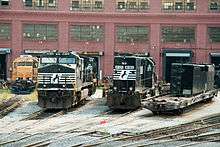
- Altoona, PA – Altoona Works
- Bellevue, OH
- Chattanooga, TN
- Conway, PA – Conway Yard
- Elkhart, IN
- Harrisburg, PA – Enola Yard
- Roanoke, VA – Shaffer's Crossing Locomotive Shop
- Roanoke, VA – Roanoke Locomotive Shop
NS also shares interest with CSX in the Oak Island Yard, managed by Conrail Shared Assets Operations in Newark, New Jersey.
Environmental record
On January 6, 2005, a NS derailment resulted in a large amount of chlorine and diesel fuel being released into nearby waterways in Graniteville, South Carolina. In addition, a toxic cloud covered the city resulting in the town being evacuated. Federal common carrier laws prevent railroads from refusing to transport chlorine and similar Toxic Inhalation Hazard (TIH) commodities. Local wildlife was killed, many of the local crops and vegetation were contaminated or killed, nine human deaths were reported, and thousands were injured.[16] The company is being taken to court and being fined for violating the Clean Water Act and the Federal Superfund law. NS has spent a total of $26 million for the cleanup.[17]
In early spring of 2008, the state program manager for air quality planning in Georgia, Jimmy Johnston, had been talking to NS about voluntary upgrades to reduce the company's environmental impact. NS is upgrading 3,800 of its locomotives with new technology that is 73 percent more efficient than previous models. The new technology being put into the locomotives is making the ride more fuel efficient and reducing idle time.[18]
NS has also introduced an experimental battery-electric switcher locomotive, NS 999. This prototype locomotive was developed by Norfolk Southern, in collaboration with the United States Department of Energy, the Federal Railroad Administration and the Pennsylvania State University.[19]
Locomotive and rolling stock
Paint and colors
NS's locomotives are often called "catfish" by railfans, as the stripes are said to look like catfish whiskers. EMD GP59 no. 4610 was painted in predecessor Southern colors of green and white with gold trim and was a favorite of railfans. The work was done at the Debutts Yard in Chattanooga, Tennessee during the summer of 1994 and the locomotive received a repaint in the summer of 2004. The locomotive was repainted standard NS black and white in February 2012.
The current paint scheme for NS locomotives is black and white, with yellow grab irons and step-edge highlights. Locomotives feature a rearing horse decal enclosed in the "catfish" stripes on both the nose and rear, which is consistent with marketing campaigns where NS has billed itself as "The Thoroughbred of Transportation".
Norfolk Southern painted 20 new-order ES44ACs and SD70ACes in commemorative heritage paint schemes as part of NS's 30th anniversary celebration in 2012 (more info below in the "Heritage Schemes" section).
Locomotives
Historically, NS has only purchased DC traction diesel locomotives, and was one of the last North American AC-traction hold-outs aside from Canadian National Railway. In September 2008, however, NS placed its first order for new AC traction locomotives: 23 GE ES44ACs, numbered 8000-8023 In the years since, NS has purchased several more ES44ACs as well as over 150 EMD SD70ACes. NS has taken delivery of several older EMD locomotives from various US Class I railroads, including 9 ex-BNSF "tri-clops" SD60Ms, 6 ex-ATSF (BNSF) SD75Ms, the remaining 12 ex-Conrail SD80MACs owned by CSX, and a majority of Union Pacific's SD9043MACs.
Norfolk Southern is the only railroad ever to own SD80MACs and SD90MACs simultaneously. The SD90MACs are currently being rebuilt into SD70ACus. NS has bought 46 GE ET44AC Locomotives, also known as Tier 4 Locomotives. The Locomotive Numbers are 3600-3646.


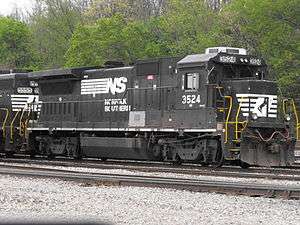 NS #3524 GE B32-8 at NS Hinman Yard
NS #3524 GE B32-8 at NS Hinman Yard NS #3067 GP40-2 with it new paint scheme sits in the snow at Botford Yard
NS #3067 GP40-2 with it new paint scheme sits in the snow at Botford Yard- A NS GP38-2 in Dover, Delaware, with depot in background
 SOU 4610 working train GD01 in Dalton, Georgia, on January 19, 2006
SOU 4610 working train GD01 in Dalton, Georgia, on January 19, 2006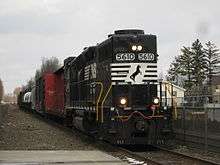 A NS GP38-2 running long hood forward through Ridgewood, New Jersey,on NS H07 the reverse H8K on the Southern Tier and NJ Transit Main Line on March 1, 2008
A NS GP38-2 running long hood forward through Ridgewood, New Jersey,on NS H07 the reverse H8K on the Southern Tier and NJ Transit Main Line on March 1, 2008
 A GE C40-9W leads a train on October 12, 2008
A GE C40-9W leads a train on October 12, 2008 Front view
Front view
Heritage fleet
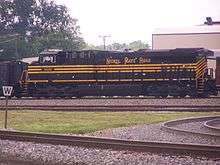
In the first half of 2012, Norfolk Southern painted 10 EMD SD70ACe's and 10 GE ES44AC's as special heritage units, each bearing the paint schemes and markings of the various predecessor railroads of Norfolk Southern and Conrail. On July 1–3, 2012, all 20 units gathered together at the North Carolina Transportation Museum at Spencer, North Carolina, as the highlight of NS's 30th-anniversary celebration. The locomotives have since traveled throughout the United States on various Class I railroads as run-through pool power, attracting much attention from railfans.[20][21][22][23]
The Heritage Units include:
|
|
Steam excursion programs
After the 1982 merger, NS President Robert Claytor retained the Southern Railway's steam excursion program begun in the 1960s by his brother, SR president W. Graham Claytor. At the time of the merger, the excursion trains were increasing in length due to the rising popularity of the steam program, and the railroad was seeking larger steam engines capable of pulling additional passenger cars. NS initially used former Chesapeake and Ohio 2716, which had been modified and decorated as Southern locomotive for the steam program, but the engine developed severe mechanical issues after less than a year in excursion service, and was replaced by Nickel Plate 765. Merging with the Norfolk & Western Railway prompted the steam program to acquire and overhaul Norfolk & Western 611, which was returned to operating status in 1984, and Norfolk & Western 1218 in 1987. These two locomotives, and 765, joined steam program veterans Southern Railway 4501 and Savannah and Atlanta Railroad 750, as well as Nickel Plate 587, Louisville and Nashville Railroad 152, Atlanta and West Point 290, Tennessee Valley Railroad 610, and Frisco 1522 for an extensive series of excursions throughout the late 1980s and early 1990s. Norfolk Southern management was forced to end the program in late 1994 citing safety concerns, rising insurance costs, the expense of maintaining the steam locomotives, and decreasing rail network availability due to a surge in freight traffic.[24]
In 2010, the railroad announced that steam excursions on the mainline would return; under the 21st Century Steam program, Norfolk Southern planned to offer steam-powered excursion trains across the entire system over a 5-year period. Rather than re-opening their own steam locomotive repair shop, NS partnered with the Tennessee Valley Railroad Museum and the Fort Wayne Railroad Historical Society to use Southern Railway 630 and Nickel Plate 765, respectively. NS provided diesel helper locomotives as-needed, sometimes supplying heritage units, and overhauled several coaches for excursion use. Other passenger cars came from the steam locomotive operators, or were rented from private owners.
The program began in 2011 with excursions in the south powered by 630 and in the north by 765. In 2013, the group "Fire Up 611!" began fundraising to restore N&W J class 611 to working order to participate in the new steam program. The locomotive was moved from its static display at the Virginia Museum of Transportation to the North Carolina Transportation Museum in 2014 to be overhauled at the Spencer shops. That same year, TVRM completed their restoration of Southern Railway 4501, which joined the 21st Century Steam program for the 2015 season, pulling excursions in Tennessee, Virginia, and Georgia. The overhaul of N&W 611 was completed in May 2015, celebrated with a run to Roanoke, Virginia, where it was originally built. The 611 pulled several excursions in Virginia, and featured in special events at the North Carolina Transportation Museum. The 21st century steam program was formally concluded at the end 2015.
In 2016, 611 once again pulled excursions in North Carolina and Virginia, with excursions sponsored by the North Carolina Transportation Museum or the Virginia Museum of Transportation, rather than Norfolk Southern. After the excursion schedule was completed, 611 would spend time at the North Carolina Transportation Museum for "At The Throttle" sessions and behind-the-scenes tours, returning to static display at the Virginia Museum of Transportation in September 2016. It has not yet been announced if 611 will continue to pull excursions in 2017.
Rolling stock
| Type | Owned | Leased | Total | Total Capacity (Tons) |
|---|---|---|---|---|
| Gondola | 33,820 | 3,839 | 37,659 | 4,098,830 |
| Hopper | 15,234 | 521 | 15,755 | 1,737,636 |
| Box | 12,356 | 1,470 | 13,826 | 1,151,821 |
| Covered hopper | 10,558 | 158 | 10,716 | 1,182,466 |
| Flat | 2,506 | 1,133 | 3,639 | 335,196 |
| Other | 4,608 | 87 | 4,695 | 225,067 |
| Total | 79,082 | 7,208 | 86,290 | 8,731,016 |
Reporting marks
Although it has been widely known as simply "Norfolk Southern" since 1982, the corporate structure and reporting marks are more complicated. In 1999, when most of Conrail's former PRR trackage was sold to the Norfolk Southern Railway, the Pennsylvania Railway Lines was created and PRR reporting marks used on the former Conrail motive power and rolling stock.
|
|
Television commercials
On September 3, 2007, NS launched a television ad featuring a family of gas cans trekking to meet a NS train, meant to underscore the railroad's role in reducing highway congestion. Shot in Virginia's Shenandoah Valley, it features the song "You Don't Need Me" written and performed for NS by Ravi Krishnaswami of New York and Steve Kolander of Atlanta.[26] On National Train Day in May 2013, NS premiered a new ad series, using music adapted from "Conjunction Junction" from ABC's School House Rock series and showing an overhead view of Inman Rail Yard in Atlanta.[27][28]
Awards and recognition
From 1989 to 2012, NS won the Gold (first-place) E.H. Harriman Award in Group A (line-haul railroads whose employees worked 15 million employee-hours or more) every single year.[29] The award, which recognized the railroads with the lowest casualty rates per 200,000 employee-hours, was discontinued in 2012.[30]
In January 2011, NS Chairman and CEO Wick Moorman was named Railroader of the Year by Railway Age magazine.[31]
See also
- History of railroads in Michigan
- Southern Railway's Spencer Shops (now a museum in Salisbury, North Carolina)
- List of Norfolk Southern predecessor railroads
- Thoroughbred Shortline Program
Improvement projects
- Crescent Corridor - Louisiana to New Jersey
- Heartland Corridor - Midwest to Norfolk
Cultural references
Trade unions
- United Transportation Union
- Brotherhood of Locomotive Engineers & Trainmen
- American Train Dispatchers Association
- Transportation Communications International Union
References
- 1 2 3 4 5 6 7 8 "NORFOLK SOUTHERN CORP 2013 Annual Report Form (10-K)" (XBRL). United States Securities and Exchange Commission. February 14, 2014.
- 1 2 "NORFOLK SOUTHERN CORP 2014 Q1 Quarterly Report Form (10-Q)" (XBRL). United States Securities and Exchange Commission. April 23, 2014.
- ↑ "About NS". Norfolk Southern Corporation. Retrieved 5 January 2014.
- ↑ NSCorp: "System Overview map"
- ↑ List of federally regulated railway operators
- ↑ 2015 Annual Report. Norfolk, VA: Norfolk Southern Corp. 2016. p. K9.
- ↑ "Norfolk Southern Building Has Engraving Error", Richmond Times-Dispatch, July 12, 1982, Pg 12
- ↑ "A Line in Time". The NS Story. Norfolk Southern Corporation. Retrieved 5 January 2014.
- 1 2 "Norfolk Southern merger family tree". Trains Magazine. Kalmbach Publishing Co. 2 June 2006. Retrieved 14 January 2009.
- ↑ Norfolk Southern Corporation (May 10, 2013). "Norfolk Southern Names Six to Senior Management Positions" (Press release). Retrieved March 4, 2014.
- ↑ "Pan Am Railways and Norfolk Southern Create the Patriot Corridor to Improve Rail Service and Expand Capacity in New York and New England" (Press release). Norfolk Southern Corp. 2008-05-15. Retrieved 2008-05-15.
- ↑ Norfolk Southern Railway and Pan Am Railways (2008-05-16). "Introducing the Patriot Corridor" (PDF). Norfolk Southern Corp. Retrieved 2008-05-16.
- ↑ "2 railroad freight companies combine effort". AP Business News. Worcester Telegram & Gazette. Associated Press. 2008-05-15. Retrieved 2008-05-16.
- ↑ "US Board Approves Joint Ownership of Pan Am Southern LLC". CNN Money. Archived from the original on 2009-04-29. Retrieved 12 March 2016.
- ↑ "Norfolk Southern Intermodal". Nscorp.com. Retrieved 2014-01-05.
- ↑ "Railroad accused of water pollution in SC wreck". The Times and Democrat. Associated Press. April 24, 2008. Retrieved 2013-02-07.
- ↑ Fretwell, Sammy (April 25, 2008). "Feds sue railroad in Graniteville disaster". The State. Archived from the original on 2008-04-26.
- ↑ "New limits on trains could help Macon's air", Macon Telegraph, Macon.com. April 9, 2008. Accessed May 6, 2008.
- ↑ "Batteries ARE included: Norfolk Southern unveils experimental electric locomotive | Norfolk Southern – The Thoroughbred of Transportation | Creating green jobs shipping freight by rail". Nscorp.com. 2009-09-28. Retrieved 2012-05-15.
- ↑ "Norfolk Southern to debut heritage fleet - TRAINS Magazine". Trn.trains.com. 2012-03-26. Retrieved 2012-05-15.
- ↑ "Norfolk Southern celebrates colorful heritage with historic paint schemes | Norfolk Southern – The Thoroughbred of Transportation | Creating green jobs shipping freight by rail". Nscorp.com. 2012-03-01. Retrieved 2012-05-15.
- ↑ "NS Diesel Locomotive Roster - GE ES44AC (ES-44AC) Nos. 8000-8115". Nsdash9.com. 2012-05-04. Retrieved 2012-05-15.
- ↑ "NS EMD SD70ACe Order Rolling Out in Heritage Schemes… | Eastern Railroad News Online Magazine". Easternrailroadnews.com. 2012-05-09. Retrieved 2012-05-15.
- ↑ https://www.washingtonpost.com/archive/politics/1994/10/29/norfolk-southern-plans-to-end-nostalgic-steam-locomotive-program/18caf343-d584-4a5c-bde7-ed3e68cd4da1/ Retrieved Oct 29, 1994.
- ↑ "2013 Form 10-K". Norfolk Southern Corp. Retrieved 5 January 2014.
- ↑ "Norfolk Southern – The Thoroughbred of Transportation | Creating green jobs shipping freight by rail". Nscorp.com. Retrieved 2012-05-15.
- ↑ "Norfolk Southern - What's Your Function?". Retrieved 2013-06-08.
- ↑ Norfolk Southern to rock National Train Day Railroad rolls out trains, family fun, and a new twist on an old classic | Norfolk Southern – The Thoroughbred of Transportation | Creating green jobs shipping freight by rail. Nscorp.com (2013-05-09). Retrieved on 2013-07-23.
- ↑ http://www.nscorp.com/nscportal/nscorp/Media/News%20Releases/2010/harriman.html
- ↑ AAR names winners of E.H. Harriman, Harold F. Hammond safety awards (5/9/2012)
- ↑ Vantuono, William C., "Wick Moorman Norfolk Southern produces champion", Railway Age, January 2011
External links
| Wikimedia Commons has media related to Norfolk Southern Railway. |
- Official Norfolk Southern company website, including a system map
- Norfolk Southern system map
- Norfolk Southern News
- Norfolk Southern Photo Archive
- Norfolk Southern Locomotives
-
- Business data for Norfolk Southern: Google Finance
- Yahoo! Finance
- Reuters
- SEC filings
- Yahoo! - Norfolk Southern Corporation Company Profile
